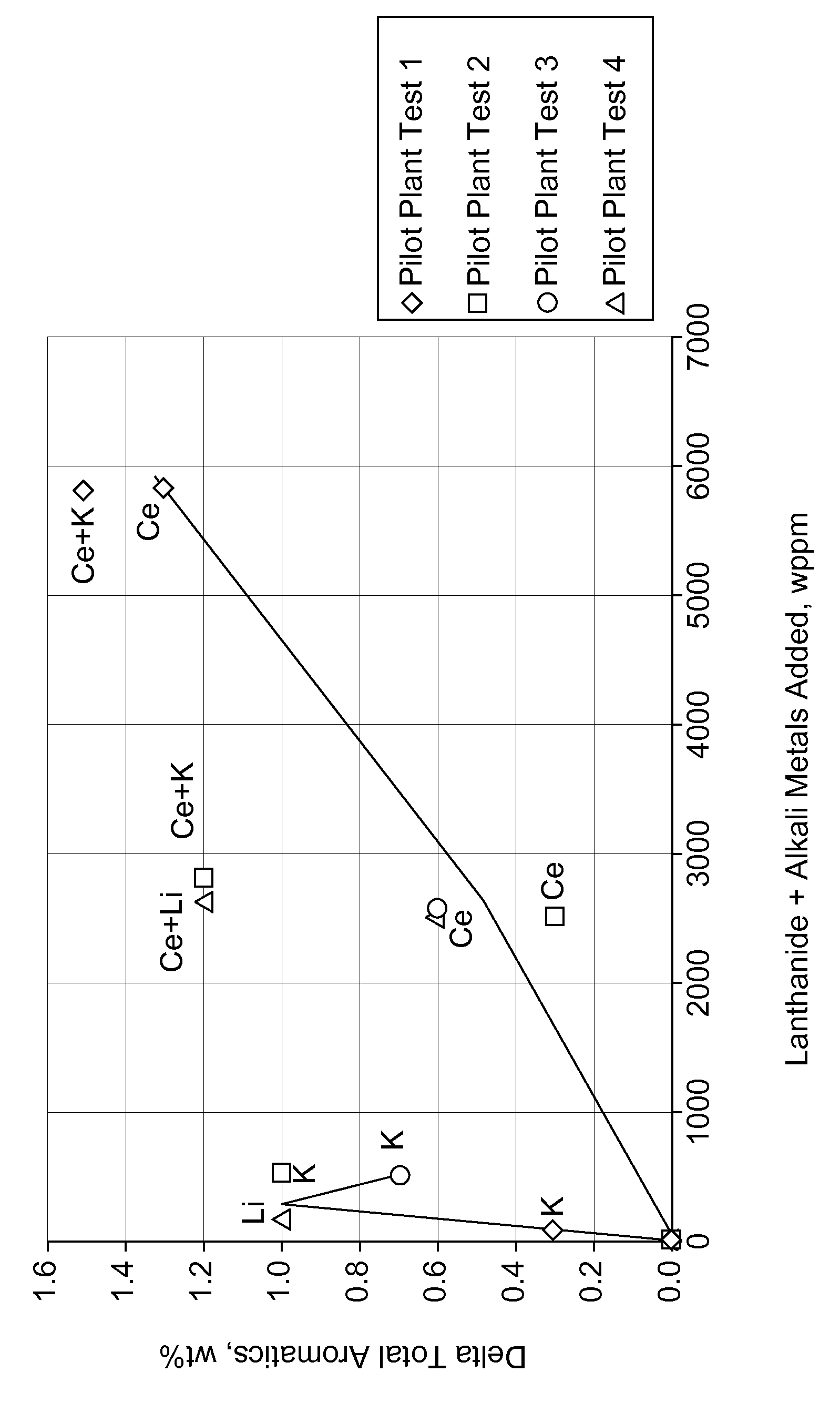Catalyst for conversion of hydrocarbons
a technology for hydrocarbon conversion and catalyst, which is applied in the direction of physical/chemical process catalyst, metal/metal-oxide/metal-hydroxide catalyst, hydrocarbon oil treatment product, etc., can solve the problems of undesired higher costs and the effect of reducing the yield of products boiling in the gasoline range, and achieves high yields of one or more c5+
- Summary
- Abstract
- Description
- Claims
- Application Information
AI Technical Summary
Benefits of technology
Problems solved by technology
Method used
Image
Examples
example 1
[0065]Spherical reforming catalysts were made containing Pt, Sn, Cl, the lanthanide metal Ce, and the alkali metals K or Li. The alumina base was made via the oil drop method where the Sn was incorporated into the aluminum sol. For Catalyst A, the alumina base was impregnated with chloroplatinic acid with HCl and H2O, dried, oxychlorinated and reduced. The sample was then further oxychlorinated at 510° C., and reduced in 15 mol % H2 / N2 at 565° C. The composition of Catalyst A was 0.25 wt % Pt, 0.29 wt % Sn, and 1.04 wt % Cl.
[0066]Catalysts B, C and D were made on a similar alumina base as Catalyst A. The alumina base was impregnated with chloroplatinic acid and cerium chloride with HCl and H2O, dried, oxychlorinated at 510° C., and reduced in 15 mol % H2 / N2 at 565° C. (Catalyst B). The composition of Catalyst B was 0.25 wt % Pt, 0.3 wt % Sn, 1.03 wt % Cl and 0.58 wt % Ce.
[0067]For Catalyst C, the alumina base was impregnated with a solution of potassium chloride with H2O, calcined, ...
example 2
[0071]This example demonstrates the increase in desired total aromatic yields and the decrease in the less desired C1 to C4 light ends obtained on reforming catalysts made by combining the alkali metals and lanthanide metals. All catalysts were pilot plant tested in reforming pilot plants at a constant research octane of 104.3 by continuously increasing the furnace temperatures. The conditions were hydrogen / hydrocarbon mole ratio of 3, 1.7 hr−1 liquid hourly space velocity, and 345 kPa (50 psig) reactor pressure. The naphtha feed for each run was substantially the same and contained paraffins, naphthenes and aromatics.
[0072]Catalysts A, B, C and D were pilot plant tested. The following Table shows the total aromatics and light end yields for these catalysts and the delta yields as compared to Catalyst A. The addition of 70 wppm of K and 0.57 wt % Ce (Catalyst D of this invention) resulted in a total aromatic yield higher than reference Catalyst A made with no lanthanide or alkali me...
example 3
[0073]Catalyst E, F, G and H were pilot plant tested. The following Table shows the results of the tests and the delta yields compared to the reference Catalyst E. The addition of 300 wppm K and 0.25 wt % Ce (Catalyst H of this invention) resulted in a total aromatic yield higher than reference Catalyst E made with no lanthanide or alkali metals, higher than Catalyst F which contained the lanthanide metal but no alkali metal, and higher than Catalyst G which contained the alkali metal but no lanthanide metal. The following Table further shows a benefit for Catalyst H in reduced lights-ends C1+C2 and C3+C4 yields compared to Catalysts E, F and G.
PUM
| Property | Measurement | Unit |
|---|---|---|
| atomic numbers | aaaaa | aaaaa |
| density | aaaaa | aaaaa |
| density | aaaaa | aaaaa |
Abstract
Description
Claims
Application Information
 Login to View More
Login to View More - R&D
- Intellectual Property
- Life Sciences
- Materials
- Tech Scout
- Unparalleled Data Quality
- Higher Quality Content
- 60% Fewer Hallucinations
Browse by: Latest US Patents, China's latest patents, Technical Efficacy Thesaurus, Application Domain, Technology Topic, Popular Technical Reports.
© 2025 PatSnap. All rights reserved.Legal|Privacy policy|Modern Slavery Act Transparency Statement|Sitemap|About US| Contact US: help@patsnap.com

